The sacred animals of Ancient Egypt
The sacred animals of Ancient Egypt
The sacred animals of Ancient Egypt
-
Hannah
-
Hannah

Baboon
This primate is found in art dating as far back as the Predynastic Period; as well as featuring in wall paintings, it was a motif used in jewellery and little statues. Babi was the sacred baboon, a deity of the Underworld and the son of Osiris. In order to pass into the afterlife, a person had to have their heart measured on the scale of Maat against the feather of truth by Thoth, god of the moon, of wisdom, of writing and of judgment. Should the balance show the person to be sinful and thus unworthy, Babi would devour their soul.
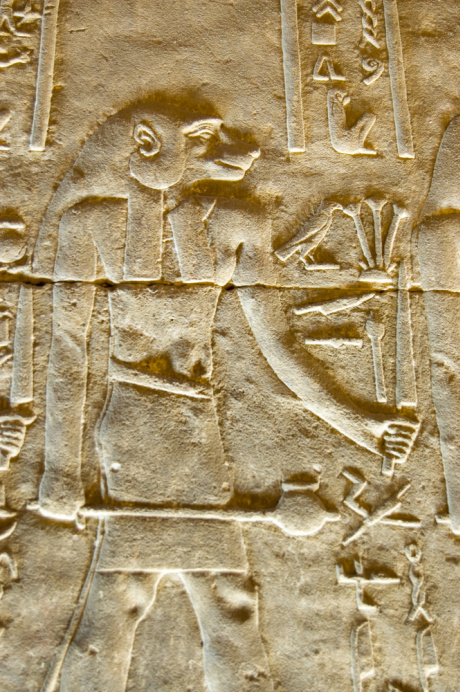
Babi depicted at the Temple of Horus, Edfu
Babi was also associated with virility after death, and it was written that he had the ‘door-bolt of the sky’, thus was empowered to open and close the gate to heaven.
Sometimes Thoth was depicted with the head of a baboon; he was closely associated with this animal, and with the ibis (see below). Another god, Hapy, was a baboon too: Hapy was one of the Four Sons of Horus, who were personifications of the four canopic jars in which the organs were stored after death. Hapy protected the lungs.

Set of canopic jars, Museum of Ancient Egypt Culture, Barcelona
Ibis
The god Thoth was often depicted as a man with an ibis head, and the ibis was seen as his living incarnation. People would mummify ibises in order to leave them as offerings for Thoth at temples, and the mummies would be buried nearby in vast catacombs – many millions of mummified ibises have been discovered in modern times in sites across Egypt. There were even special breeding farms for ibises in order to meet demand for the offerings.

Thoth depicted at the Temple of Ramses II, Abydos
Crocodile
The crocodile, like the hippopotamus (see below), was a highly dangerous and thus deeply feared creature in Ancient Egypt. Through deification, people sought to protect themselves from the crocodile: through worshipping it they would, they hoped, appease it.
Sobek, god of the Nile, was a crocodile-headed man imbued with all the qualities of the mighty Nile crocodile: he was the god of pharaonic power and military prowess; he could provide great protection to the people (just as a mother crocodile will protect her eggs and young); and he was a god of fertility.
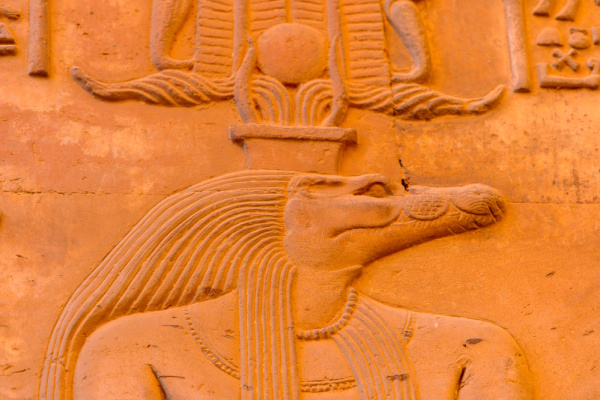
Sobek, Temple of Kom Ombo
The city of Faiyum was the centre of the cult of Sobek and became known as Crocodilopolis or Crocodile City. In temples devoted to the god priests kept a live sacred crocodile; like with the ibis, upon its death it would be mummified and buried.
Hippopotamus
In ancient times, the River Nile was home not only to crocodiles but also to hippopotami – immense and incredibly fearsome. Taweret, meaning ‘she who is great’, was a goddess of childbirth and fertility; she was depicted as a hippopotamus, reflecting how fiercely the mother hippo guards her young. She was a protector of mothers and children, and her imagery is found in all manner of items used in the home for protection, most notably in ‘wands’ carved from hippo ivory.
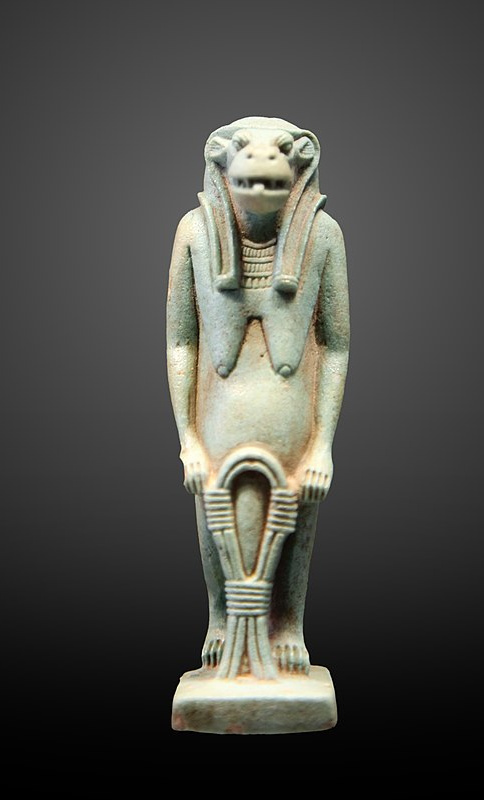
Taweret amulet, the Louvre
People also associated hippos with rebirth and renewal. A hippo would submerge for some time in the river, with only the top curve of its back visible, before resurfacing; this called to mind the creation story of the primeval mound emerging from the waters of Nun. A hippo model placed in a tomb, then, would help the deceased to be reborn. The most famous surviving such model is affectionally known as William and is in the collection of the Met museum, New York City.

‘William’, the Met
Scarab beetle
This beetle, now known as the dung beetle, was symbolic of rebirth and regeneration: their rolling dung into a ball was associated with the sun god Ra rolling the sun across the sky each day. Ra was sometimes combined with the god Khepri, god of the rising son, who was depicted as a scarab holding the sun, or a man with a whole scarab as a head.

Khepri statue, Karnak Temple Complex, Luxor
Scarab amulets and seals were immensely popular, and many have survived to this day. They were also used in funerary practices; a heart scarab, for example, was laid over a mummy’s heart in order to prevent it from giving evidence against the deceased at the time of judgement.
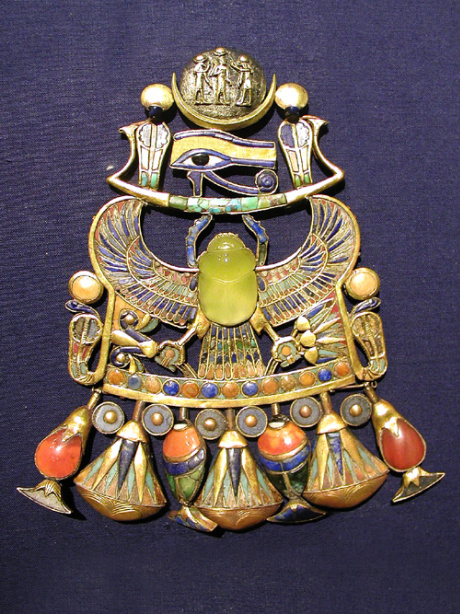
Scarab in a pendant, tomb of Tutankhamun
Cat
The cat was the incarnation of Bastet, the goddess of protection, perfume/ointments, fertility, pregnancy, children, music, the arts, warfare – and cats. She was originally depicted with the head of a lion, but over time this became the head of a cat.
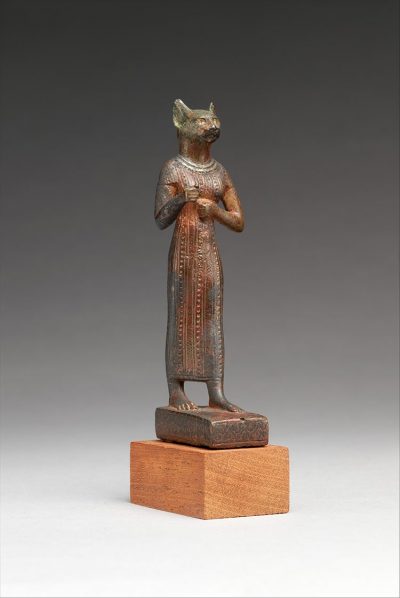
Bastet statue, the Met
We know much about cats in Ancient Egypt from the many, many depictions of them found in tombs and temples, in art, in statues and in jewellery. They were treated with great respect, and when a cat died it would often be mummified, to be buried when the time came with its master. According to the Book of the Dead, this would ensure both master and cat would cross into the afterlife, and the cat would continue to act as protector to the master.
Jackal
Finally, we come to the jackal, or dog, which is associated with the deity Anubis, god of death, mummification, embalming, the afterlife, cemeteries, tombs and the Underworld. He was usually depicted as a man with the head of a jackal or as a seated jackal, as in this statue found in the tomb of Tutankhamun.
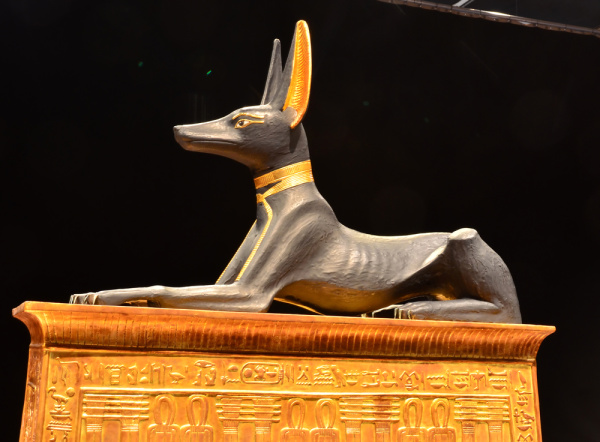
Statue of Anubis, tomb of Tutankhamun
Picture credits: Babi: BasPhoto/Shutterstock; Hapy: WH_Pics/Shutterstock; Thoth: BasPhoto/Shutterstock; Sobek: Anton_Ivanov/Shutterstock; Taweret Rama/Wikipedia; William: public domain/Wikipedia; Khepri: Mountains Hunter/Shutterstock; scarab: Jon Bodsworth/Wikipedia; Bastet: The Metropolitan Museum of Art/public domain; Anubus: mountainpix/Shutterstock.
Thanks, I really enjoy mythology. Most of what I have been exposed to is from Greece (Athens, Crete, and Syracusa, Sicily), Italy, Turkey, and Roman Spain/
All fascinating places too. Thank you for reading.